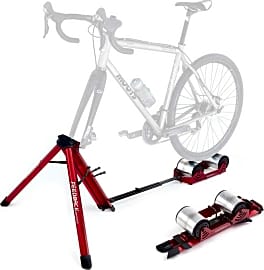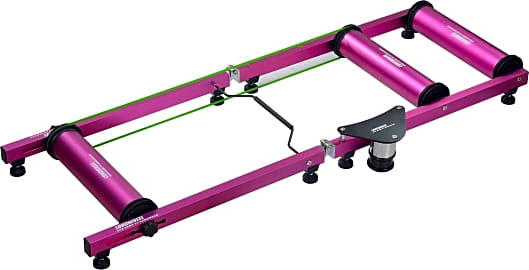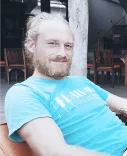The 10 Best Bike Rollers

This wiki has been updated 39 times since it was first published in April of 2015. Whether you enjoy cycling just for fun or are a serious competitor, one of these bike rollers can help you stay in shape through the winter or any other time the weather outside is rough. All they require is a few feet of floor space and your bicycle to provide you with a taxing workout. Just a word of caution, though: they take some getting used to and should be used with care when starting out. When users buy our independently chosen editorial picks, we may earn commissions to help fund the Wiki.
Editor's Notes
April 06, 2021:
Not only a great way to keep in shape during the winter months, but a good quality bike roller also helps to improve your riding skills and develop pedal technique and body control. If your pedaling is jerky or inconsistent then the bike will bounce on the rollers, giving an unnatural feeling and most likely causing the rider to fall. In addition, rollers are usually cheaper, lighter, and easier to set up than a trainer, making them a versatile piece of equipment for riders of any skill level. In this update, we removed several models that are no longer available and replaced them with options with modern features to reflect various riding and training requirements.
The Z6 Riding Base is an entry-level model, which, similar to the Feedback Sports Omnium, features a tripod support that attaches to the front forks and holds the bike stable. These models are a good starting point as they don't require any balancing force, however, they do take longer to set up as the front wheel needs to be removed. The Longwheel Indoor was added to the ranking as it is a very lightweight option that folds away into a canvas carrying bag, making it a good choice if portability is important. It also has multiple adjustable feet for stability on carpets or uneven floors. Finally, we included the Sport Crafters Double Overdrive, which is one of the only models designed specifically for recumbent trikes. It boasts a unique roller mechanism that automatically adjusting in resistance as the rider changes speed, or, when turned the opposite way, allows for resistance-free pedaling.
January 09, 2020:
If you can't train outdoors due to poor weather or time constraints, and you find bike trainers too mind numbing, then you may want to give one of these bike rollers a try. Since both of your wheels are actually spinning, just like they do when cycling outdoors, and you need to balance yourself while pedaling, they offer a much more realistic riding experience than trainers. That being said, the same things that allow them to offer a truer road-like cycling experience also make them much harder to use than bike trainers, so expect a bit of a learning curve if you have never used one before.
We recommend everyone except very experienced users buy a model with parabolic rollers. This style of roller dips inwards slightly from the edges towards the center, which helps to keep your tires in the middle of the drums as you train. Except for the Kreitler KT-10001, CycleOps 9501, and CyclingDeal Premium, all of the other models on our list features parabolic rollers. That being said, the Kreitler KT-10001 is a very high-quality unit equipped with CNC-machined drums with near perfect concentricity, ABEC-5 sealed cartridge bearings, and aluminum end caps, all of which allow it to create a good momentum and maintain it while coasting, so it is a good choice for proficient users who want a smooth and seamless experience.
For beginners we recommend the Elite Arion Digital Smart B+, Elite Quick-Motion, and Feedback Sports Omnium. Both Elite models feature the company's patented floating roller system. This allows the rollers to swing slightly forwards or backwards as you accelerate or decrease your speed, which absorbs some of your momentum and makes it easier to stay balanced on your bike. The Feedback Sports Omnium is essentially a combination of a standard bike trainer and roller. It leaves your rear wheel free to spin, just like with a roller, but takes the place of your front wheel and keeps you perfectly balanced the whole time, so there is little chance of falling off.
Special Honors
TruTrainer SmartLoad Power Roller The SmartLoad Power Roller can be purchased as an upgrade to your current TruTrainer roller or as a complete package with the platform. It is powered by your pedaling alone, and once your start spinning it over eight miles per hour it wakes up and connects to the associated smartphone app via Bluetooth, where it can record training data and you can customize your workout using manual, target power, or wind and grade settings. trutrainer.com
Misuro B+ This Bluetooth-enabled smart sensor is designed to be used on Elite's range of home trainers and rollers. It provides fundamental training data via proprietary software, allowing you to accurately monitor speed, power, and cadence. elite-it.com
Before The Bicycle Roller
They are bulky items and when not in use, they simply take up space or collect dust.
Long before the invention of bicycle rollers, there was the stationary bike. As difficult as it may be to believe, stationary bicycle machines have been around since the late 1700s. Though early machines such as the Gymnasticon may not have exactly resembled a bicycle, they used a nearly identical system. The Gymnasticon was composed of flywheels that spun in response to foot pedals or cranks, mobilizing and strengthening the user's body. One set of flywheels was attached to two large wooden pedals, while another set was attached to a hand crank for the arms. These machines paved the way for stationary bicycles and elliptical machines.
Exercise bikes have come a long way since the 18th century. Modern stationary bikes come with cutting edge features like integrated heart rate monitors and video display screens. Most exercise bikes are made to emulate a standard bicyle; equipped with a seat, handlebars, and two peddles attached to a drive mechanism. This drive mechanism will spin either an external wheel or an internal gear.
Most stationary bikes are also equipped with mechanisms to control the amount of resistance the user experiences when riding them; giving the user the power to increase or decrease the intensity of their workout.
There are downsides to stationary bikes as well. They are bulky items and when not in use, they simply take up space or collect dust. Stationary bikes do not feel exactly like actual bikes, and may work slightly different muscle groups than a standard bike. This is a big problem if the user is riding a stationary bicycle to gain muscle strength for riding their standard bike outdoors. Exercise bikes are also perfectly balanced. This is a necessity, as an imbalanced unit would easily topple and cause injury. This balance also means that the abdominal muscles of the rider are hardly engaged. On an actual bike, the core muscles act to keep the bike stable and balanced.
Why Bike Rollers Are The New Norm
The drawbacks of a stationary bicycle machine are the main reasons why bike rollers are taking over the realm of indoor cycling. The lack of stability when using a bicycle roller forces the rider to engage their core as well as their legs. This translates to a more effective workout and a more productive training regimen.
For those looking to declutter their lives, not having a large stationary bike taking up most of the free space in a room is often reason enough to get a bike roller.
Bicycle rollers may seem like a new invention, but they have actually been around for over 100 years. The original models were made of large wooden rollers on a wooden frame, while modern models are made of aluminum alloys and durable plastics. However, the concept and application remains the same. Bicycle rollers provide the user with unequaled balance and coordination training, while allowing them to use their existing bicycle for indoor exercise.
Because the user is training on the same bicycle as they will be using outdoors, the same exact muscles are targeted during bicycle roller training. The rider also has full control over torque and resistance while using the gears of the bicycle. This gives the rider much more practical knowledge into things such as their ideal cadence and what each individual gear feels like. All while remaining in a safe, controlled environment.
When an exercise session is completed, the roller can easily be broken down and placed under the bed, in a closet, or behind a chair. For those looking to declutter their lives, not having a large stationary bike taking up most of the free space in a room is often reason enough to get a bike roller.
Bicycle Riding As A Low Impact Workout
Many people turn to bicycling as a form of burning calories, staying active, and getting in shape. In fact, the average rider can burn 650 calories in one hour of simple cycling. An avid cyclist may use different gears for a more intense workout and burn upwards of one thousand calories per hour.
Unfortunately, this force often ends up in the knees, ankles, and hips of the body; wearing them down over time.
Burning calories is not the only thing riding a bicycle is good for. Riding on a bicycle actually provides a variety of health benefits. Studies have shown that just 30-60 minutes of simple exercise a day can help prevent many serious health issues, such as type 2 diabetes, cardiovascular disease, and certain cancers.
Bicycle riding is also a low-impact workout. Any aerobic exercise which offers a small amount of strain to the body is considered a low impact workout. Exercises like yoga, cycling, and swimming are great examples. These activities promote health by strengthening the body; but do so in ways that are not as harmful as high impact workouts.
In contrast, high impact workouts are aerobic activities which bring strength and muscle tone to the body; yet do cause unnecessary strain. Running is one such activity which has become synonymous with high levels of stress placed on the joints. The force created from a runner's body weight landing on one foot has to go somewhere. Unfortunately, this force often ends up in the knees, ankles, and hips of the body; wearing them down over time.
Simply switching to a low impact workout such as cycling can rest and actually strengthen the joints and connective tissues in the legs.















